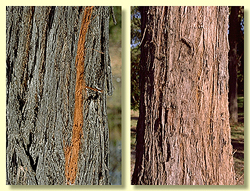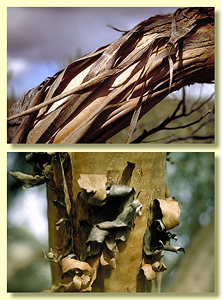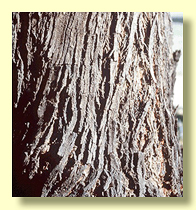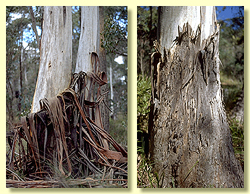
Ironbark: hard, compacted, furrowed; over whole trunk
Perhaps the easiest bark to recognize is that of the traditional ironbarks. In these species, the rough bark becomes hard, compacted and furrowed with age and varies in colour from grey to black or red-black. Some ironbark species, however, have all the appearance of the hard, furrowed ironbark character, yet the bark is actually soft and somewhat flaky and friable as in some forms of E. fibrosa and E. placita. Therefore, the ironbark character may refer more to appearance and expectation rather than to fact! In some species of unrelated groups (e.g. E.sieberi, E. aromaphloia, and E. indurata) the rough bark may be thick, hard and furrowed as in the ironbarks.

Red bloodwoods

Yellow bloodwoods

Ghost gums
Tessellated: red bloodwoods, yellow bloodwoods, ghost gums
The outer dead bark breaks up into small flakes (tesserae or tessellations). This bark may be loose or firmly held to the whole trunk and branches. In bloodwoods, when the outer, most weathered flakes are lost by attrition, an orange and brown mottling of the newly exposed underbark is often produced. The texture of the rough bark is somewhat corky. Among the red bloodwoods, particularly inland and desert species, the tessellated bark is not retained over the whole trunk (e.g. E. chippendalei). The flakes are looser and are most prominent on the lower trunk while the upper trunk is often smooth. There is no wholesale shedding of the flakes in these bloodwoods and the trunk remains permanently and colourfully mottled. There is a smaller group with tessellated bark (yellow bloodwoods) in which the outer, unshed bark is always loose but remains attached covering the whole trunk and branches. The outermost layers weather to light brown or greyish brown or shades of faded yellow but are readily lost by attrition exposing the underlayers which are bright yellow to golden such that the yellow bloodwood trees in a forest of mixed species can be easily seen from a distance. Examples are C. peltata and C. eximia. While this type of bark characterizes the yellow bloodwoods, it also occurs (though often less spectacularly) in the unrelated northern species E. similis, E. lirata and E. cloeziana.
Another group, (ghost gums), has a distinctive type of tessellated bark or lacks rough bark altogether. Some species are completely smooth-barked (e.g. C. aparrerinja) while others have a basal stocking of distinctive tessellated rough bark with an abrupt cut-off line on the trunk (e.g. C. tessellaris). Even in the smooth-barked species, the tessellated nature of the bark is often revealed after fire when the newly killed basal bark breaks up into rough flakes which are then shed. Box species often have some tessellated rough bark (e.g. E. bridgesiana, E. moluccana,and E. hypostomatica). In the grey box, white box and black box groups, the outer rough bark is rough, usually firmly held, somewhat fibrous though compacted, and ultimately breaks up into small tessellations. When the outermost, that is, the oldest part of the fragments fall away, unweathered whitish inner bark is exposed giving a dark, grey and white mottled pattern to the whole trunk. In large old box trees the rough bark often becomes looser, shaggy and furrowed, particularly towards the base.

Stringybarks

Peppermints / Mahoganies
Stringy or fibrous: stringybarks, peppermints, mahoganies
This is a large group of species that can usually be recognized by the thick, longitudinally-furrowed, fibrous bark over the whole trunk such that the bark can be pulled away in long strings, ie. stringybarks (e.g. E. macrorhyncha) and some other species (e.g. Angophora floribunda). The inner layers of stringy or fibrous bark can usually be seen to be criss-crossed. In some mallee species belonging to the group, the stems may be mostly smooth but the characteristic stringy bark can usually be seen towards the base. The outer rough bark weathers to greyish but on stripping the rough bark away, the underbark will usually be found to be a rich reddish colour. Some stringybark species have the rough bark to the small limbs, but a few have notably smooth branches (e.g. E. blaxlandii). In another large group, the peppermints, the bark is rough over the trunk and often the branches. The rough bark is similar to that of the stringybarks but is thinner and does not become coarsely furrowed in the old trees and the criss-cross pattern of the underbark is often conspicuous. A small group, the white mahoganies e.g. E. acmenoides, is notable for the rough fibrous bark being held more or less in flattish strips, rather than loose criss-cross fibres, although the character is difficult to categorise unambiguously. This type of rough bark is also seen conspicuously in the famous Western Australian endemic, jarrah (E. marginata). The stringybarked bloodwood, C. jacobsiana, from the Northern Territory is another example of a type of finely fibrous stringybark.

Box: short-fibred, grey, sometimes mottled grey and white or even brown-yellow
The boxes e.g. E. populnea are one of the most difficult groups to summarize. The bark is often tightly held, sometimes tessellated (see above), but may, in some species, be quite flaky. Thickness is variable and shedding is irregular or in many species does not occur at all. The boxes are a large group of closely related species, but box-type bark also occurs in other distantly related species (e.g. E. angophoroides)

Imperfectly shed ribbons, strips or curls
The bark on the stems, and possibly the larger limbs, appears loosely rough, due to the imperfect shedding of dead bark. The general appearance is quite variable depending on whether a given species normally sheds in long coarse ribbons, shorter thin strips or in irregular flakes. For example E. horistes often has a rough trunk clothed in coarse, partly detached ribbons which hide the living bark; E. praetermissa has its trunk lightly covered with thin short strips of dead bark; and E. astringens has a trunk that is often almost smooth but seasonally may have numerous small rough curling flakes of dead bark adherent to the surface giving a scruffy appearance.
The 'imperfectly shed ribbons, strips or curls' should not be confused with 'loose basal slabs' which implies a thicker accumulation of dead bark usually on the lower stem or bole.

A few species (e.g. E. elata) have rough bark for the basal 1-3 m only. They may be known as blackbutts. This originally fibrous bark becomes suffused with exudates and hardens the bark somewhat similarly to the unrelated ironbarks. The bark colour is invariably very dark brown to black. In E. sieberi this type of bark may cover the whole trunk and be quite fissured or furrowed, while the branches are conspicuously smooth.

Loose basal slabs: apparently rough, particularly the lower bole
All smooth-barked species shed their dead bark at some time. Many species, particularly in cultivation, hold some of their dead bark loosely over the bole for some time before it is shed. Particularly old individuals may also exhibit this character. This type of 'rough' bark is to be distinguished from distinct, firmly-held rough bark. Clearly, this is an ambiguous bark type which takes experience to assess. If no decision can be made, this and another bark form should be selected, or the rough bark character bypassed altogether.





